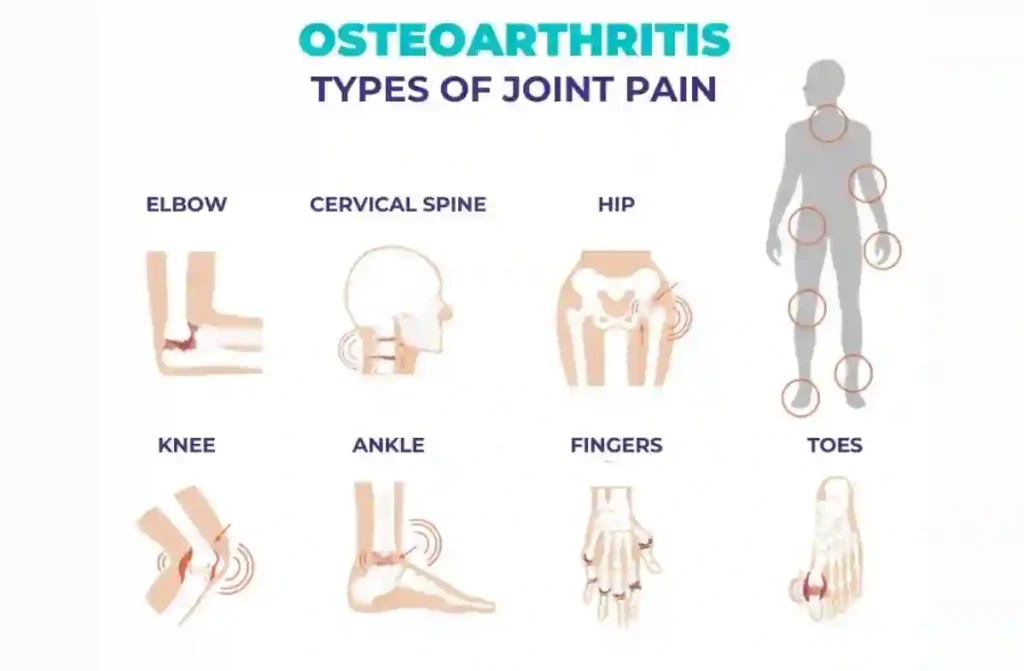Joint pain can be incredibly uncomfortable, affecting your day-to-day activities and quality of life. Finding the right treatment for joint pain is essential to get relief and restore your mobility. Whether your joint pain is caused by arthritis, injury, or wear and tear, there are various options available to help alleviate your discomfort. In this blog, we’ll explore what joint pain is, its causes, risk factors, and the best treatment for joint pain to help you feel better.
What is Joint Pain?
Joint pain is discomfort, soreness, or aching in one or more of your joints. It can range from mild to severe and might affect how easily you can move. Common areas for joint pain include the knees, hips, shoulders, and hands. While joint pain may occur due to aging, it can also be caused by various conditions like arthritis, injury, or infections.

Causes of Joint Pain
Several factors can lead to joint pain, including:
- Arthritis: One of the most common causes of joint pain, especially in older adults. Osteoarthritis and rheumatoid arthritis are two common types.
- Injury: Damage to the cartilage, tendons, or ligaments around the joint can cause pain.
- Bursitis: Inflammation of the bursae (fluid-filled sacs) around joints.
- Tendonitis: Inflammation or irritation of tendons can also lead to joint pain.
- Gout: A type of arthritis caused by a buildup of uric acid crystals in the joints.
Understanding the cause of your joint pain is essential for determining the right treatment for joint pain and stiffness.
Risk Factors for Joint Pain
Certain factors increase the likelihood of developing joint pain, including:
- Age: As we age, the wear and tear on our joints increases, making us more prone to joint pain.
- Obesity: Carrying excess weight puts extra pressure on your joints, especially in the knees, hips, and spine.
- Previous Injuries: If you’ve had an injury in the past, the joint might be more vulnerable to pain and discomfort later on.
- Physical Activity: High-impact activities or overuse of joints can contribute to joint pain over time.
- Medical Conditions: Certain diseases, like arthritis or gout, increase your risk for joint pain.
By identifying these risk factors, healthcare providers can create a more tailored treatment for joint pain.
Prevention of Joint Pain
Preventing joint pain is essential to maintaining an active and pain-free lifestyle. Here are some effective strategies:
- Maintain a Healthy Weight: Reduces pressure on weight-bearing joints like knees and hip replacement.
- Stay Active: Regular exercise strengthens muscles around the joints.
- Balanced Diet: Include foods rich in omega-3 fatty acids, calcium, and vitamin D for joint health.
- Protect Your Joints: Use proper posture and avoid repetitive strain on joints.
- Adequate Rest: Allow recovery time after physical activities.
Implementing these practices can significantly reduce the risk of joint pain. For those seeking the best joint pain relief, combining lifestyle changes with professional advice can be particularly effective. Consult a specialist if you experience persistent joint discomfort.
Diagnosis of Joint Pain
Accurate diagnosis is key to effective treatment for joint pain. Medical evaluation typically includes:
- Medical History: Understanding symptoms, duration, and activities causing pain.
- Physical Examination: Assessing joint movement, swelling, or tenderness.
- Imaging Tests: X-rays, MRIs, or CT scans to detect structural issues.
- Lab Tests: Identifying inflammation or autoimmune conditions through blood tests.
- Joint Aspiration: Examining joint fluid for infections or gout.
Early diagnosis improves the chances of effective knee joint pain relief, allowing for targeted treatment and better outcomes. Regular check-ups help monitor joint health and catch issues early.
Treatment for Joint Pain by Dr. Prakash Selvam
Dr. Prakash Selvam is a highly experienced orthopedic specialist known for providing effective knee joint pain relief and advanced treatments for various joint conditions. He holds an MBBS, MS in Orthopedics, and has extensive experience in treating joint pain through surgical and non-surgical methods.
- Medications and Injections – Anti-inflammatory drugs and corticosteroid injections to reduce pain and swelling.
- Physiotherapy and Rehabilitation – Strengthening exercises to improve joint flexibility and function.
- Minimally Invasive Surgery – Arthroscopy and other advanced procedures for long-term relief.
- Lifestyle Modifications – Weight management and dietary recommendations to reduce joint stress.
For expert care and knee joint pain relief, visit Dr. Prakash Selvam at:
Clinic Address: V2, Plot 4047, 4th Main Rd, V Block, Anna Nagar, Chennai, Tamil Nadu 600040
Phone Number: +91 94980 33340
Consult with a specialist to create a tailored treatment plan for lasting knee joint pain relief.

Surgical Options to Relieve Joint Pain
When other treatments fail to provide best joint pain relief, surgery might be recommended as a treatment for joint pain. Some common surgical procedures include:
- Joint Replacement Surgery: For severe arthritis, replacing the joint with an artificial one (such as in a knee or hip replacement) can restore function and reduce pain.
- Arthroscopy: A minimally invasive procedure used to diagnose and treat joint problems.
- Fusion Surgery: In cases where joint movement causes pain, fusing the bones together can prevent further discomfort.
- Osteotomy: This procedure involves reshaping the bones to relieve pressure on the joints.
While surgery can offer long-term knee joint pain relief, it’s usually considered a last resort after non-surgical treatments have been tried.
Symptoms of Joint Pain
Joint pain often begins subtly—easily mistaken for fatigue or post-workout soreness. But recurring discomfort or stiffness may signal a deeper issue. Early recognition helps in choosing the right treatment for joint pain and stiffness before it worsens.
- Morning Stiffness: Joints feel tight or slow to move after waking.
- Swelling or Warmth: Localized swelling may indicate inflammation or fluid buildup.
- Limited Movement: Difficulty bending, stretching, or rotating the joint.
- Persistent Ache or Sharp Pain: Pain during rest or activity that lingers.
- Grinding or Popping Sounds: May suggest cartilage wear or early arthritis.
- Weakness or Instability: Joint gives out or feels unsupported during movement.
Noticing these signs early allows for timely, effective treatment—minimizing damage and restoring mobility.
When Should Joint Pain Be Treated by a Healthcare Provider?
Mild joint pain management may go away on its own with rest, but there are times when it’s important to consult a healthcare provider:
- Chronic Pain: If your joint pain lasts more than a few weeks, it’s time to seek medical attention for your best joint pain relief.
- Severe Swelling: Swelling that doesn’t go down with rest or over-the-counter treatments should be evaluated.
- Fever: If you experience fever along with joint pain, this could indicate an infection and requires immediate medical attention.
- Sudden Onset: If your joint pain comes on suddenly, especially after an injury, it’s best to see a doctor to rule out fractures or ligament tears.
Knowing when to seek help is key to getting the appropriate treatment for joint pain.
What to Expect at Your Office Visit
When you visit a healthcare provider for joint pain relief, here’s what you can expect:
- Medical History: The doctor will ask about your symptoms, any recent injuries, and whether you’ve had joint problems in the past.
- Physical Examination: They will check your joint for swelling, tenderness, and range of motion.
- Imaging Tests: X-rays, MRIs, or ultrasounds may be ordered to get a clearer picture of what’s causing your pain.
- Treatment Plan: Based on the diagnosis, your doctor will recommend a personalized treatment plan, for knee joint pain relief which could include medication, physical therapy, or surgery if necessary.
Getting professional advice is crucial to finding the best treatment for joint pain that suits your needs.
Diet and Natural Remedies for Joint Pain
A healthy diet and natural remedies can play a significant role in managing joint pain and improving mobility. Certain foods help reduce inflammation and strengthen bones, while natural approaches can offer relief without side effects.
Beneficial Foods for Joint Health:
- Fatty fish (like salmon and mackerel): Rich in omega-3 fatty acids to fight inflammation
- Leafy greens (such as spinach, kale): High in antioxidants and vitamin K
- Nuts and seeds: Contain healthy fats that support joint lubrication
- Turmeric: Contains curcumin, a natural anti-inflammatory compound
- Berries and citrus fruits: Packed with vitamin C to protect joints
Natural Remedies:
- Hot and cold compresses: Help ease stiffness and pain
- Epsom salt baths: Soothe sore joints
- Gentle exercise and stretching: Maintain flexibility
- Massage therapy: Boosts circulation and reduces stiffness
Incorporating these strategies can contribute significantly to knee joint pain relief and overall joint wellness.
Conclusion
If you’re experiencing joint pain, it’s important to explore all your options for treatment for joint pain. From lifestyle changes and medications to physical therapy and surgical options, there are plenty of ways to find relief. Whether you’re dealing with mild discomfort or chronic pain, consulting a healthcare provider can help you get the proper treatment. For professional care and expert advice, contact CTS Hospital, one of the best places for joint pain treatment.
